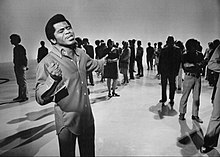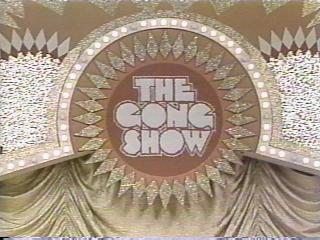
The Gong Show is an American amateur talent contest franchised by Sony Pictures Television to many countries. It was broadcast on NBC's daytime schedule from June 14, 1976, through July 21, 1978, and in first-run syndication from 1976 to 1980 and 1988 to 1989, and was revived in 2017 for broadcast on ABC. The show was created and originally produced by Chuck Barris, who also served as host for the NBC run and from 1977 to 1980 in syndication. Its most recent version was executive-produced by Will Arnett and hosted by Tommy Maitland, a fictional character performed by Mike Myers. The Gong Show is known for its absurdist humor and style, with the actual competition secondary to the often outlandish acts presented; a small cash prize has typically been awarded to each show's winner.

Stephen Valentine Patrick William Allen was an American television and radio personality, comedian, musician, composer, writer, and actor. In 1954, he achieved national fame as the co-creator and first host of The Tonight Show, which was the first late-night television talk show.
The year 1969 in television involved some significant events. Below is a list of television-related events in 1969.

Your Show of Shows is a live 90-minute variety show that was broadcast weekly in the United States on NBC from February 25, 1950, through June 5, 1954, featuring Sid Caesar and Imogene Coca. Other featured performers were Carl Reiner, Howard Morris, Bill Hayes, baritone singer Jack Russell, Judy Johnson, the Hamilton Trio and the soprano Marguerite Piazza. José Ferrer made several guest appearances on the series.
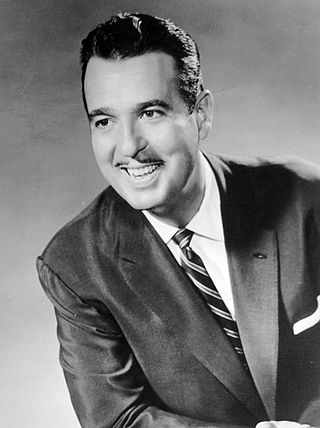
Ernest Jennings Ford, known professionally as Tennessee Ernie Ford, was an American singer and television host who enjoyed success in the country and western, pop, and gospel musical genres. Noted for his rich bass-baritone voice and down-home humor, he is remembered for his hit recordings of "The Shotgun Boogie" and "Sixteen Tons".

A laugh track is an audio recording consisting of laughter usually used as a separate soundtrack for comedy productions. The laugh track may contain live audience reactions or artificial laughter made to be inserted into the show, or a combination of the two. The use of canned laughter to "sweeten" the laugh track was pioneered by American sound engineer Charles "Charley" Douglass.
Variety show, also known as variety arts or variety entertainment, is entertainment made up of a variety of acts including musical performances, sketch comedy, magic, acrobatics, juggling, and ventriloquism. It is normally introduced by a compère or host. The variety format made its way from the Victorian era stage in Britain and America to radio and then television. Variety shows were a staple of English language television from the late 1940s into the 1980s.

Dinah Shore was an American singer, actress, and talk show host. Shore rose to prominence as a recording artist during the Big Band era. She achieved even greater success a decade later in television, mainly as the host of a series of variety programs for the Chevrolet automobile company.

The Lawrence Welk Show is an American televised musical variety show hosted by big band leader Lawrence Welk. The series aired locally in Los Angeles for four years, from 1951 to 1955, then nationally for another 16 years on ABC from 1955 to 1971, followed by 11 years in first-run syndication from 1971 to 1982. Repeat episodes are broadcast in the United States by PBS stations. These airings incorporate an original program — usually, a color broadcast from 1965 to 1982 — in its entirety. In place of the commercials, newer performance and interview clips from the original stars and/or a family member of the performers are included; these clips are occasionally updated.
Ozark Jubilee is a 1950s American television program that featured country music's top stars of the day. It was produced in Springfield, Missouri. The weekly live stage show premiered on ABC-TV on January 22, 1955, was renamed Country Music Jubilee on July 6, 1957, and was finally named Jubilee USA on August 2, 1958. Originating "from the heart of the Ozarks", the Saturday night variety series helped popularize country music in America's cities and suburbs, drawing more than nine million viewers. The ABC Radio version was heard by millions more starting in August 1954.

Turn-On is an American surreal sketch comedy series created by Digby Wolfe and George Schlatter that aired once on ABC on Wednesday, February 5, 1969. Only one episode was shown partially before being pulled from ABC's airing schedule, leaving another episode unaired. The show has since been considered one of the most infamous flops in TV history, with significantly low initial ratings and negative critical reception.
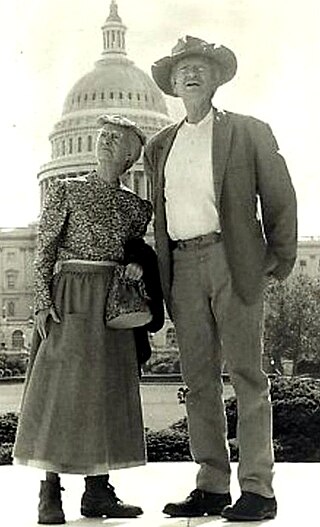
The "rural purge" refers to the mass cancellation in the early 1970s of rural-themed television programs by American networks, in particular CBS. The term was coined within the entertainment industry, although its exact provenance is unclear. The majority of these cancellations occurred at the end of the 1970–71 television season. In addition to rural-themed shows such as Mayberry R.F.D., The Beverly Hillbillies, Petticoat Junction, and Green Acres, the cancellations ended several highly rated variety shows that had been on CBS since the beginning of television broadcasting. CBS saw a dramatic change in direction with the shift, moving away from shows with rural themes and toward more appeal to urban and suburban audiences.
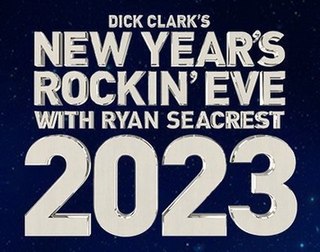
Dick Clark's New Year's Rockin' Eve (NYRE), billed since 2008 as Dick Clark's New Year's Rockin' Eve with Ryan Seacrest, is a New Year's Eve television special broadcast by ABC. The special broadcasts primarily from New York City's Times Square and prominently features coverage of its annual ball drop event hosted by television personality Ryan Seacrest, along with live and pre-recorded musical performances by popular musicians from Times Square and Hollywood. Since 2016–17, the special has regularly included performances and coverage of midnight festivities from other U.S. locations, including New Orleans and San Juan.

The Pink Panther Show is a showcase of animated shorts produced by David H. DePatie and Friz Freleng between 1969 and 1978, starring the animated Pink Panther character from the opening credits of the live-action films. The series was produced by Mirisch Films and DePatie–Freleng Enterprises, and was broadcast Saturday mornings on two American television networks: from September 6, 1969, to September 2, 1978, on NBC; and from September 9, 1978, to September 1, 1979, on ABC.
The 1955–56 network television schedule for the four major English language commercial broadcast networks in the United States. The schedule covers primetime hours from September 1955 through March 1956. The schedule is followed by a list per network of returning series, new series, and series cancelled after the 1954–55 season.
The following is the 1951–52 network television schedule for the four major English language commercial broadcast networks in the United States. The schedule covers primetime hours from September 1951 through March 1952. The schedule is followed by a list per network of returning series, new series, and series cancelled after the 1950–51 season. This was the first television season of national network interconnection by coaxial cable and microwave, meaning programming could be transmitted live coast-to-coast if needed.

The Chamber Music Society of Lower Basin Street is a musical variety radio program which began on the Blue Network on February 11, 1940.
Midwestern Hayride, sometimes known as Midwest Hayride and later Hayride, was an American country music show originating in the 1930s from radio station WLW and later from television station WLW-T in Cincinnati, Ohio. During the 1950s it was carried nationally by NBC and then ABC television.
